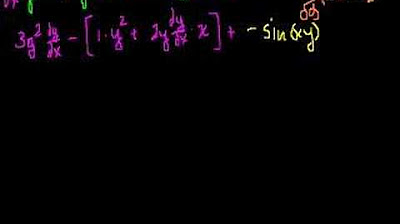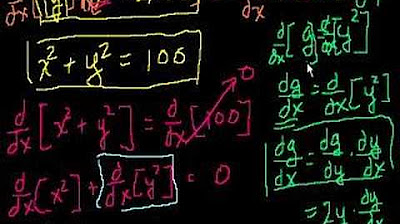Second derivatives (implicit equations): find expression | AP Calculus AB | Khan Academy
TLDRThe video script presents a step-by-step guide on finding the second derivative of y with respect to x for the given equation y^2 - x^2 = 4 using implicit differentiation. The process involves taking the first derivative to isolate dy/dx, and then using the product rule and chain rule to compute the second derivative, resulting in an expression of -x^2/y^3. The explanation is clear, emphasizing the application of fundamental calculus concepts.
Takeaways
- 📚 The given equation is y^2 - x^2 = 4, and the goal is to find the second derivative of y with respect to x.
- 🔍 Implicit differentiation is used as it avoids solving for y, which could involve square roots and complicate the process.
- 📈 The first step is to find the first derivative of y with respect to x, using the chain rule and basic differentiation rules.
- 🌟 The first derivative is found to be (dy/dx) = x/y by applying the chain rule and simplifying the equation.
- 🔄 To find the second derivative, we take the derivative of both sides of the first derivative equation with respect to x.
- 📝 The quotient rule and product rule are applied to the second derivative calculation, which involves rewriting the first derivative as a product for easier manipulation.
- 🎓 The derivative of y^(-1) is calculated using the power rule, which is crucial for finding the second derivative.
- 🔢 The second derivative (d^2y/dx^2) is simplified to be -x^2/(y^3), which is the final expression in terms of x and y.
- 💡 The process demonstrates the importance of understanding and applying the chain rule, product rule, and power rule in differentiation.
- 📊 The example serves as a clear illustration of how to handle complex differentiation problems involving quadratic expressions.
- 🌐 The solution maintains a focus on the mathematical process, without the need to solve for y explicitly, showcasing an efficient approach to problem-solving.
Q & A
What is the given equation in the problem?
-The given equation is y^2 - x^2 = 4.
What is the goal of the problem?
-The goal is to find the second derivative of y with respect to x and express it in terms of x and y.
Why might solving for y not be the best approach in this problem?
-Solving for y might not be the best approach because the presence of y^2 could involve taking a square root, which may complicate the differentiation process.
What alternative method is suggested for solving the problem?
-The alternative method suggested is implicit differentiation, which is an application of the chain rule.
What is the first step in using implicit differentiation?
-The first step is to find the first derivative of y with respect to x by taking the derivative of both sides of the given equation with respect to x.
What is the expression for the first derivative of y with respect to x?
-The first derivative of y with respect to x is (dy/dx) = x / y.
How is the second derivative of y with respect to x found?
-The second derivative is found by taking the derivative of the expression for the first derivative (dy/dx) = x / y with respect to x.
What mathematical rule is used to find the derivative of the expression x / y?
-The quotient rule is used to find the derivative of the expression x / y.
What is the final expression for the second derivative of y with respect to x?
-The final expression for the second derivative of y with respect to x is (d^2y/dx^2) = -x^2 / y^3.
How does the problem demonstrate the application of the chain rule?
-The problem demonstrates the application of the chain rule in finding the first and second derivatives of y with respect to x, especially when dealing with the y^2 term and the x / y expression.
What is the significance of the power rule in this problem?
-The power rule is significant in this problem when finding the derivative of y to the negative one power, which is part of the process to calculate the second derivative.
Outlines
📚 Introduction to Implicit Differentiation
This paragraph introduces the concept of implicit differentiation as a method to find the derivative of a function that is not explicitly expressed in terms of one variable. The instructor presents an equation, y squared minus x squared equals four, and sets a goal to find the second derivative of y with respect to x. The paragraph explains the process of taking the first derivative using the chain rule and then proceeds to find the second derivative by applying the product rule and power rule. The explanation is detailed, walking through each step of the differentiation process, including handling the constant term and the quotient rule. The paragraph concludes with the final expression for the second derivative, which is minus x squared over y cubed.
Mindmap
Keywords
💡Implicit Differentiation
💡Chain Rule
💡First Derivative
💡Second Derivative
💡Quotient Rule
💡Product Rule
💡Power Rule
💡Derivative of a Constant
💡Simplifying Expressions
💡Rate of Change
💡Differentiation
Highlights
The problem presented is to find the second derivative of y with respect to x for the given equation y^2 - x^2 = 4.
Instead of solving for y and using traditional techniques, implicit differentiation is suggested as a more straightforward approach.
Implicit differentiation involves applying the chain rule to both sides of the equation, which is a key method for this problem.
The first step is to find the first derivative of y with respect to x, which is done by differentiating both sides of the equation.
The derivative of y^2 with respect to y is 2y, and by applying the chain rule, this becomes 2y * (dy/dx).
The derivative of x^2 with respect to x is 2x, and the derivative of a constant is zero.
The first derivative of y with respect to x is found to be (dy/dx) = x/y.
The next step is to find the second derivative by differentiating the expression for the first derivative with respect to x.
The quotient rule and the product rule are used to find the second derivative, which are essential calculus techniques.
The derivative of y with respect to x is rewritten as x * (y^(-1)), which simplifies the process of finding the second derivative.
The second derivative is found by applying the product rule to the expression x * (y^(-1)) and simplifying the result.
The final expression for the second derivative of y with respect to x is (d^2y/dx^2) = -x^2 / y^3.
The solution demonstrates the application of the chain rule, quotient rule, and product rule in calculus.
The problem-solving process showcases the importance of understanding the relationships between variables in an equation.
The method used can be applied to a variety of similar problems involving second derivatives.
The solution emphasizes the value of implicit differentiation in problems where variables are interdependent.
The process highlights the importance of step-by-step problem-solving and the application of fundamental calculus rules.
The final result is a clear demonstration of how to express the second derivative in terms of the original variables x and y.
Transcripts
5.0 / 5 (0 votes)
Thanks for rating:





